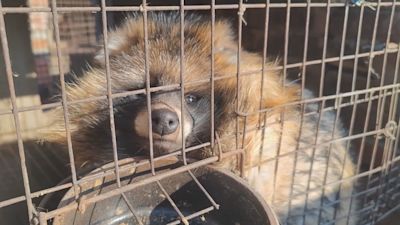Animal cruelty and a threat to global health? Inside China's fur farms

ITV News Asia Correspondent Debi Edward on the cruel fur farming industry in China that's becoming a 'ticking time bomb' of viruses
Although we had researched and seen videos about the fur markets in Northeast China, it was shocking to see in person the furs from artic foxes and minks laid out on the street for the Thursday morning market in Suning.
On a large square surrounded by shops there were pelts piled up in the open and being handled like any other piece of fabric.
In an anonymous interview with one trader, he admitted sales were down and profits not so good.
But he told us the supply of furs was still plentiful and when we asked how the animals were killed, he didn’t hesitate to tell us: they were electrocuted and then skinned.
What he described is confirmed in graphic undercover footage from the Humane Society International.
A team of their researchers visited several fur farms in China and found thousands of animals living in cruel, cramped conditions, showing clear signs of distress and neglect.
Samples taken from those sites indicate they are the potential breeding grounds for another pandemic.
The types of animals used in the fur trade, like racoon dogs, foxes and minks have characteristics that make them the ideal hosts for respiratory diseases.
On the fur farms, they are kept in wire cages, various species in close proximity. It creates the perfect conditions for viruses to emerge, mutate and spread from animal to animal, and then on to humans.
Almost forty high risk viruses were found on Chinese farms this year, thirteen of them new viruses, including one from bats.
Scientists from the UK have led calls for fur farms to be considered in the highest risk category for future disease outbreaks, alongside the bushmeat trade and live animal markets.
Although the fashion industry and consumers have largely moved away from real fur, it is still being farmed in several countries including Finland, Poland, the United States and Canada.
But China remains the largest fur-producing country in the world.
Last year China produced ten million fur pelts to be made into coats, hats and scarves, that has come down from the almost ninety million a decade ago, but it’s still a multimillion-pound industry, that remains well-stocked and has the support of the government.
In May 2020 at the height of the Covid-19 pandemic the Chinese Ministry of Agriculture and Rural Affairs changed the law to reclassify racoon dogs, foxes and minks as livestock, which means they are no longer protected by a ban on the trade of wild animals.
We reached out to the Ministry of Agriculture for a response to this report, they acknowledged they had received our questions, but they did not respond. The Ministry of Foreign Affairs told us it was for the relevant department to comment.
The UK banned fur farming 20 years ago, but still imports around a million animals worth of fur every year.
Ruth Jones MP has introduced a private members bill, calling for a complete ban.
At an event in Westminster, she told ITV News she hoped the bill would gain cross party support and pass with ease when it reaches the next stage in June 2025.
“There are other products available, there are artificial alternatives, we don’t need fur, fur belongs on the animal,” she said.
When the UK banned fur farms, 22 other countries followed suit, but without a ban on imports animal rights campaigners say the UK is still complicit in the fur trade which virologists are now warning is not only horrifically cruel for the animals but is like playing ‘’Russian roulette” with global health.
Despite global pledges to prevent another pandemic, little has been done to safeguard against it.
The poor animals being killed for their furs might prove to be the cause, but until they are saved from their fate as fashion, humans could be destined to suffer a repeat of Covid-19.
Have you heard The Trapped? Listen as Daniel Hewitt exposes the UK's dirty secret